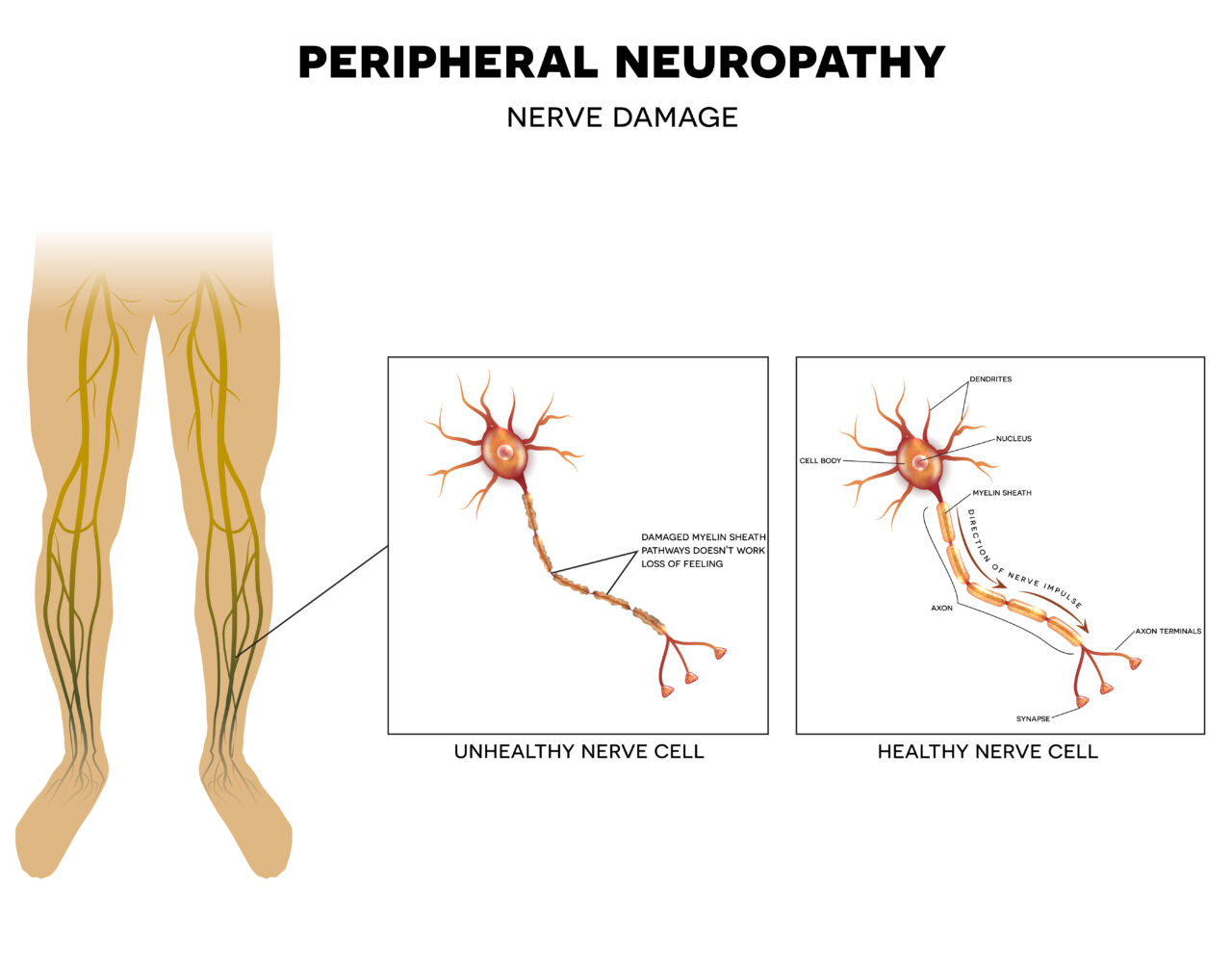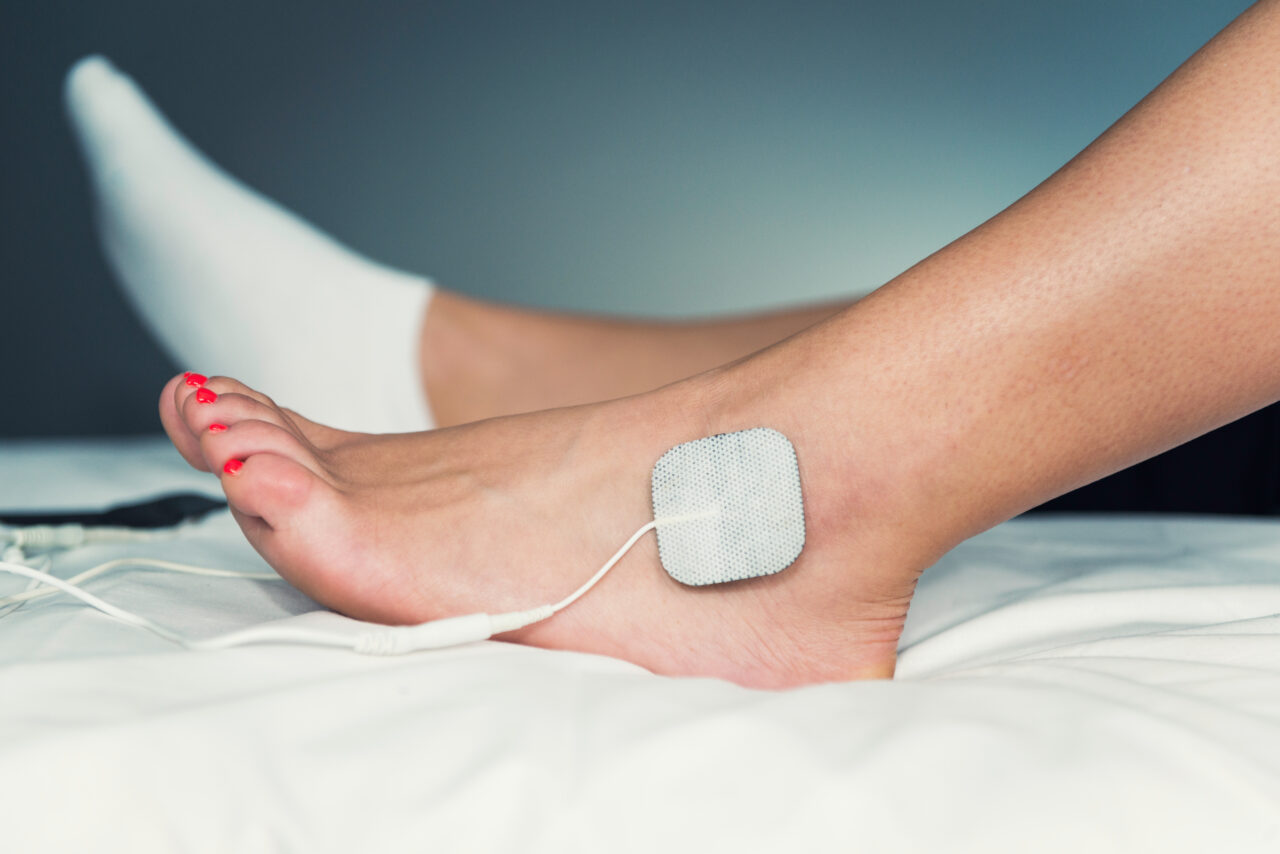Peripheral Neuropathy

What’s The Connection Between Peripheral Neuropathy And Fatigue?
Read More
March 23, 2023
If you are one of the 20 million people in the US whose lives are deeply affected by neuropathy, the chances are that you have a constant thought: finding a treatment that alleviates the pain and frees you from medications. One effective solution to consider is a TENS Unit for neuropathy.
But is TENS the best treatment option for neuropathy?
If you’ve decided to try neurofunctional pain management and electroanalgesia for neuropathy, you are on the right path. Electrical stimulation can improve blood flow, ease discomfort, and promote regeneration of nerve damage.
But, there’s a lot more that you need to know about TENS – let’s get started.
Deriving from the Greek words for “nerve” (neuron) and “condition” (pathos), neuropathy is a term used to describe the nerve damage that occurs in one or more parts of your nervous system. The term alone does not describe the underlying cause or symptom intensity of neuropathic pain, nor does it specify which part of the body is affected.
So, what causes neuropathy?
To understand this, it is crucial to understand that our body’s nervous system is divided into two parts:
The PNS is responsible for transmitting sensory information (such as pain or feeling cold) and motor signals to the brain. It also supports processes that we can’t consciously control (i.e., our heartbeat, sweating, digestion, etc).
When nerves belonging to the PNS are damaged, the signals traveling from your extremities or organs are unable to reach the brain, or they are subjected to interference.
Depending on what nerve (or nerves) is damaged, you’ll experience a range of symptoms:
In extreme cases, you might also feel as if you are wearing a glove (if the sensory nerves are affected), experience paralysis (if the motor nerves are affected), or report symptoms such as heat intolerance, excessive sweating, drops in blood pressure, and loss of bladder control (if the autonomic nerves are affected).
Everyone can experience neuropathy at any stage of life. In 20-30% of cases, neuropathic pain has no known cause (idiopathic). Nonetheless, some factors put you at greater risk of developing this condition. Let’s look at them below:

Inadequately managed health conditions, some chronic diseases, and certain treatments can lead to nerve damage. Specifically, these include:
If you have been diagnosed with alcohol use disorder, or you drink alcohol excessively for long periods, you might be at risk of neuropathy. That’s because the toxic effects of alcohol can damage the nerves’ protective sheath, called myelin, and contribute to nutritional deficiencies.
Estimations show that alcoholic neuropathy may affect 25% to 66% of those diagnosed with chronic alcohol use disorder.
Certain nutritional deficiencies can lead to nerve damage. In particular, to lower your risk of developing or worsening neuropathy, you should supplement the following vitamins and minerals to avoid deficiencies:
Some substances, such as metformin, and toxins present in food, like mercury in fish, can damage nerves in PNS.

TENS – which stands for transcutaneous electrical nerve stimulation – is a type of therapy that leverages low-voltage electric pulses to ease pain and discomfort. An at-home TENS unit is a small device that is attached to electrodes (adhesive pads) via thin wires.
When applied to the problem area, the pads deliver mild impulses of electrical current through the skin and into the nervous system. When this happens, the external impulses prevent pain signals from reaching the brain by “flooding” the nervous system. In turn, this action will stop you from feeling pain.
TENS also works by boosting the production of feel-good, pain-killing hormones, such as endorphins, and stimulating blood flow in the affected area.
Today, TENS units are commercially available, making electrical stimulation a convenient pain management method for people with arthritis, back pain, and other chronic conditions.
Although TENS is a relatively new treatment for neuropathic pain, evidence-based reviews published in 2020 show that this therapy can help alleviate pain in people with neuropathy deriving from sciatica, spinal cord injury, and postherpetic neuralgia (a consequence of shingles).
Generally, TENS is considered to be safe, and it can be administered by anyone, regardless of training or experience. This level of safety comes from the fact that at-home TENS units only deliver extremely mild electrical pulses that can’t cause pain. Additionally, they offer easy-to-use settings that can be adjusted by users without a medical background.
Nonetheless, there are some precautions you should take:
Although the efficacy of TENS as a pain management method is still being researched, recent studies have made some promising conclusions.
In a 2013 review of eight studies, electrical stimulation seemed to have a beneficial effect on patients with diabetic peripheral neuropathy, when used in conjunction with other treatments. Ongoing clinical trials also aim to prove the efficacy of electrical stimulation to delay or prevent limb amputation in patients with diabetic peripheral neuropathy, which currently accounts for 50-75% of non-traumatic amputations.
Additionally, a 2017 assessment published by the Cochrane Library showed that electrotherapy might help those with nerve damage caused by carpal tunnel syndrome and shingles.
Although still sparse, the body of research around TENS is promising. Nonetheless, it’s important to keep in mind that the beneficial effects of electrical stimulation demonstrated in the studies above were applied by medical-grade TENS devices and not at-home units.
At-home devices are created to be harmless and come with significant limitations in terms of power and wavelength. Because of this, commercially-available TENS units can’t be classified as electroanalgesic treatment.
On the other hand, when treating acute or chronic pain, patients require high-frequency pulses, which only medical-grade, FDA-approved machines can deliver. Because more powerful electrical pulses are just tolerable by the patient, this treatment can only be administered by a highly trained professional.
As seen above, at-home TENS units are generally considered safe – but are also less efficient than professionally-administered treatments. Because of this, you might be exposing yourself to unnecessary health risks when using an over-the-counter device.
Ultimately, just like any other treatment, TENS isn’t suitable for everyone, and being aware of the contradictions of this therapy can help you stay safe. Here’s what you need to know:
If you are wearing a medical device, the electrical impulses produced by TENS can interfere with the signals of your implant and lead to severe side effects. For example, if you have a pacemaker, unsupervised TENS can cause bradycardia or asystole (serious heart problems), and inhibit the functioning of your implanted device.
As seen in a 2004 review, the acrylate in the conductive gel that coats the electrodes of a TENS unit might cause skin irritation. Although rare, contact dermatitis can worsen neuropathic pain and delay treatment progress.
One of the greatest advantages of TENS is that it can be safely used without severe side effects. However, especially in the case of low-frequency electrical stimulation, you can experience muscle fatigue, spasms, and twitching due to overuse. Over time, TENS might also lead to the accumulation of waste material, which can damage the muscles in the affected area.
The positive effects of TENS for neuropathy and nerve damage can be attributed to the improved blood flow in the problem area, which also boosts the circulation of beneficial fresh oxygen and nutrients. However, if you suffer from low blood pressure, you should be aware that TENS can decrease blood pressure even further, by as much as 6.3 mmHg.
Although some studies have found that TENS can have a positive effect on patients suffering from acute facial nerve paralysis, you should never place the TENS electrodes on certain parts of your body, including your face, genitals, and abdomen.

If you have neuropathy, you know that this isn’t a simple condition to treat – or to understand.
However, thanks to today’s advances in regenerative medicine, new treatment options can help alleviate pain, strengthen the muscles, regenerate damaged nerves, and free you from unfamiliar and uncomfortable sensations.
At Relatyv, we provide our patients with a more efficient alternative to TENS, which still leverages the principles behind electroanalgesia and electrical stimulation. But we also combine these therapies with a more innovative approach to neuropathic pain treatment.
Here are some of the neurofunctional pain management therapies we provide:
To treat neuropathic pain, it’s important to understand what happens at a cellular level. In turn, to understand these processes, it’s necessary to leave our world, which is dominated by standard physics laws, and enter the world of cells, atoms, and particles.
These behave according to the laws of quantum mechanics. New technologies, such as Quantum Resonance-Specific Induction (QRSI™), allow us to interact with pain-causing mechanisms at a cellular level. This technology creates electromagnetic energy fields and electric currents that amplify subatomic particle movements that increase the healing and regenerating power of cells.
Put simply, with these tools, the team at Nuragenex uses electromagnetic resonance (the electrical signaling between cells) to optimize energy levels at a cellular level. These energized cells contribute to healing damaged tissues.
Although neuropathy is certainly a common condition, no two patients have the same story, nor do they experience the same pain. That is why generalized TENS might not be the solution you’ve been looking for.
At Relatyv, we can guide you through a personalized, holistic treatment journey to help you live a healthier, fuller, and pain-free life without medications or surgery.
About the Author
Will is a healthcare executive, innovator, entrepreneur, inventor, and writer with a wide range of experience in the medical field. Will has multiple degrees in a wide range of subjects that give depth to his capability as an entrepreneur and capacity to operate as an innovative healthcare executive.
Share on Social Media




You can see how this popup was set up in our step-by-step guide: https://wppopupmaker.com/guides/auto-opening-announcement-popups/
You can see how this popup was set up in our step-by-step guide: https://wppopupmaker.com/guides/auto-opening-announcement-popups/
Neurofunctional Pain Management Overview
Symptoms
Conditions Treated
Treatments
Articles by Category
Locations
Colorado
Wisconsin
Georgia
Hiram
Lawrenceville
Marietta
Powder Springs
Texas
Waco
Victoria
Illinois
Buffalo Grove
New Lenox
St. Charles
Arizona
Tucson
Waddell
Arlington
Avondale
Buckeye
Superior
Mesa
Palo Verde
Morristown
Tempe
Chandler
Anthem
Eloy
Florence
Fort McDowell
Phoenix
El Mirage
Coolidge
Gilbert
Arizona City
Casa Grande
Casa Blanca
Aguila
Sacaton
Apache Junction
Kearny
Stanfield
Goodyear
Litchfield Park
Alabama
Arkansas
California
Florida
Idaho
Indiana
Iowa
Kansas
Louisiana
Maryland
Michigan
Rhode Island
Minnesota
Mississippi
Nevada
New Jersey
New Mexico
North Carolina
Ohio
Pennsylvania
South Dakota
Tennessee
Utah
Virginia
Washington

